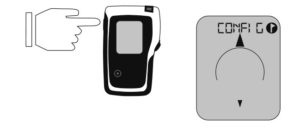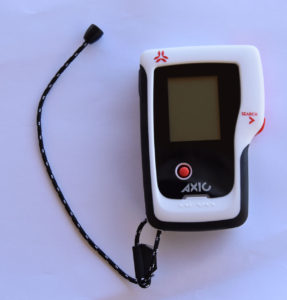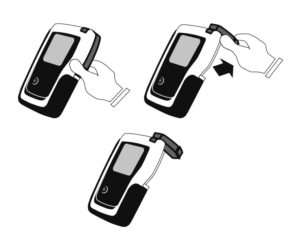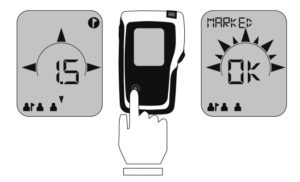The Verdict
For a single victim search the Axios is as good as any other modern digital beacon. However, if the Boy Scout in you demands advanced features and you practice enough to be a beacon searching pro, Axios provides the range and tools to help you deal with multiple burial carnage with speed and precision. It requires a fair amount of practice to learn all the nuances, but it has all the options you might want or need. Part of the practice involves figuring out what all the options are, and how to adjust them. Millennials will inevitably discover them in short order while boomers will wish there were more detailed directions written down somewhere, like how to switch to analog mode, or more likely, how to turn the dang thing off.
The Devil’s in the Details
Range
When it comes to detecting the faintest of signals, Arva’s Axios currently sets the high water mark. I’ve picked up a signal as far away as 80 meters, though never consistently and it certainly won’t lock on to the signal that far away. That doesn’t mean that a lone blip on Axios’ radar is wrong, but it isn’t strong enough for long enough to say anything about distance or direction with reliability. That overstates the problem since in a real avalanche the path already gives a sense of direction and even a momentary beep says there’s a signal available. By the time you’re 65 meters away Axios has usually locked on and it wasn’t unusual for it to be locked on by 70 meters in a single victim scenario. Even in the case of a vertical burial Axios could detect and lock-on 50 meters away. Those are stats few other beacons can equal.
This extended range is why Arva claims an aggressive search strip width of 60 meters (30 meters on either side of you). Most beacons claim a search strip width of 40 meters or less. Again, the large vertical axis antenna is the basis for this range improvement.
Unfortunately this expanded range seems to come with an increase in noise that shows up as twitchy direction arrows. It is more pronounced the further away you are. In the case of multiple signals, it seems ever present, depending on the distances between each beeper.
Ergonomics
For basic functionality the Axios is relatively intuitive. To turn it on, press the power button on the left side. To start searching, flip open the red antenna on the right underside corner. Once you get a signal, you go in the direction of the arrow as long as the distance is decreasing. This is where that twitchiness can throw you. If you’re 60 meters away and the arrow says traverse hard left but the avalanche path clearly goes straight down, then use your head and bear left as you descend. Within a few beeps the direction will stabilize. Inside of 40 meters the direction arrows are more stable, except, as indicated above, in the case of multiple signals that occasionally overlap. When you’ve located a beacon and within marking range, pressing the red joystick will mask the closest signal and then point you toward the next closest. You can configure the settings to mark the signal when you’re within 3 meters (or 5m). You’ll know you’re within marking range when a flag appears in the upper R corner of the display. Just don’t forget in a real rescue you shouldn’t flag a signal (causing it to be ignored) unless you have a probe strike for that victim.To turn the beacon off, hold the power button down about 2 seconds, or until it shows OFF at the top of the display, then give the joystick a center press and it’ll shut down pronto.
Audio Cues
Once Axios locks on to a signal it will emit a single beep that gets higher in pitch until you are within the FINAL distance (3 or 5 meters). From there the beeps double up, coming in bursts of two that, again, increase in pitch as you get closer.
Group Check
By default this function is turned on. After going through the start-up procedure Axios gives the user the option to check the transceivers in the group. To perform a group check, deploy the third antenna while GCHECK is displayed at the bottom of the screen. With the Z-antenna extended the beacon is in receive mode, and the group check function limits range to one meter. After checking each members beacon in the group give the joystick a center press before moving on to the next one. If the detected beacon has a frequency deviation the screen will indicate that and that person’s beacon should be replaced.
Special Functions
Beyond the basics Axios is challenging to learn for two reasons. First the manual is a miniature user guide masquerading as a manual. It begged for reading glasses. However, the PDF version can be zoomed in on for reading comfort. Anglophones can expect a few Frenchisms in the text but they’re close enough you will figure it out. Secondly, it assumes familiarity with navigation protocols of modern electrical devices. Younger users weaned with a smart phone will figure it out for customization but gummers like me will require more time and practice to make the key functions reflexive in a real rescue.

Press the power button (while already on) to switch to the CONFIG menu. Press the joystick to enter.
- FINAL – the distance from the victim to reliably isolate and
mark/flag (ignore) a signal: 3m or 5m. Default is 3m. - GCHECK – whether or not you want the option to do a group
check after powering up the beacon. - BACKSend – This an auto-revert to send function. Selectable
between OFF, 2, 4, or 8 minutes – default is 4 minutes to auto revert. - STANDBY – this function is for pros who are regularly
involved in search and rescue. It allows the beacon to be put into neutral,
neither sending or receiving, with a selectable auto revert time limit of 2, 4 or 8 minutes. Default is OFF. - BAND SR – enable or not automatic range reduction when Axio
senses electrical interference (default is ON) - SCROLL – turns on or off the ability to select which of
multiple signals to focus on. Default is OFF. - Reset – resets all
options to factory default settings.
Analog Mode
To Arva’s credit, analog mode is an advanced function that doesn’t need to first be turned on in the Config menu. Just press the power button momentarily when you’re in search mode and it will toggle into Analog mode. There are nine levels in analog mode and while the display no longer indicates direction it still shows distance to the closest signal on the screen. To turn the level up, push the joystick to the right, to turn it down, push left. If Axios thinks the level is too high or too low, it will indicate so with arrows to the left (turn it down a notch or two) or right (turn it up) of the distance reading.
For those unfamiliar, the advantage of an analog response is speed when bracketing to narrow down where to start probing. When a transceiver is in analog mode it hears and emits an audio beep in real time that gets louder the closer you are. By real time I mean it is only “on” when the transmitting beacon is actually on, i.e., sending out a signal. There is no delay due to digital processing, either in the strength of the signal (how loud it is) or timing. With digital processing, to be accurate, you typically have to wait a few seconds for the strength of the signal to settle in each position.
Multiple Victims
In theory Axios can indicate and keep track of up to five separate signals provided they have minimal overlap in their timing. In general Axios didn’t indicate the presence of additional signals until they were less than 20 meters away, which is a noticeable improvement over Neo. In presence of other signals Axios maintained focus on the strongest signal and once that was found and flagged (by pressing the joystick) it immediately switched to the next strongest signal. Axios offers a SCROLL feature where you can select which signal to focus on, but I was unclear in scrolling through the available icons which one corresponded to which signal? For pros with lots of practice time this might be valuable, for the rest of us I don’t see much value in this function on any beacon.
Bottom Line
If you’re a guide or a member of a search and rescue team Axios has stellar range and a host of advanced features that you will appreciate. For most backcountry skiers the extra features are not needed for single or two-victim scenarios and it works great in default mode. The difference in cost and function between an Axios or Neo can be justified if you’re familiar with using analog mode and know that it can save you time in the final phase of a search.
Arva
Axios
MSRP: $470
Weight: 240 g • 8 oz.
© 2019






Recent Comments